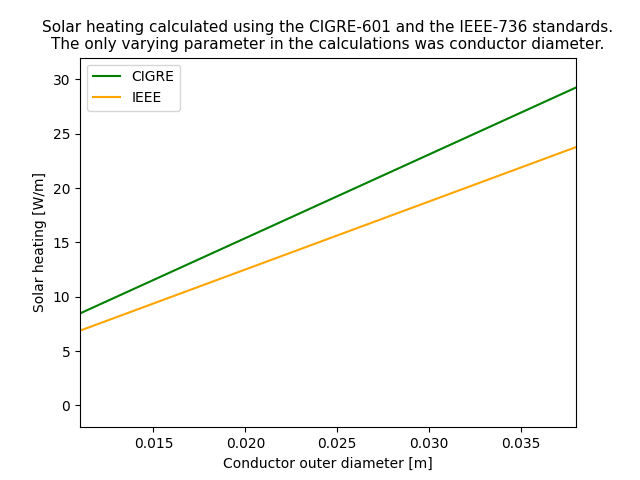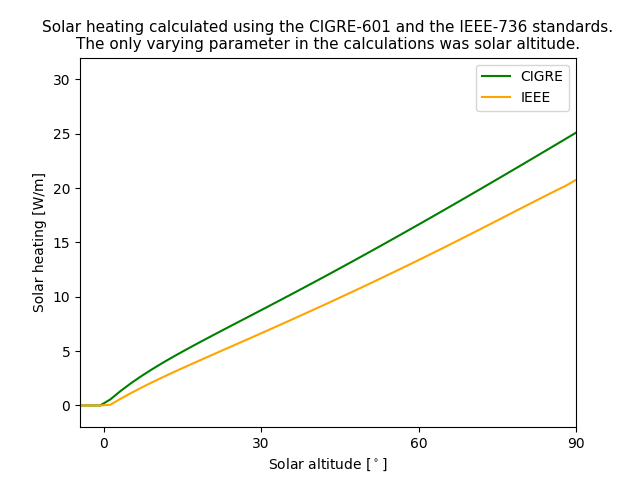Note
Go to the end to download the full example code.
Comparing the methods for calculating solar heating in CIGRE601 and IEEE738#
In this example, we see how the solar heating varies with different variables. This calculation is done using with the CIGRE-601 standard and the IEEE-738 standard.
Imports and utilities#
import matplotlib.pyplot as plt
import numpy as np
from linerate.equations import cigre601, ieee738, solar_angles, solar_heating
from linerate.equations.math import switch_cos_sin
Simulation parameters#
time = np.datetime64("2022-06-01T13:00")
omega = solar_angles.compute_hour_angle_relative_to_noon(time, 0)
delta = solar_angles.compute_solar_declination(time)
vals_with_range = {
"D": np.linspace(0.011, 0.038)[:, np.newaxis],
"sin_H_s": np.linspace(-0.05, 1)[:, np.newaxis],
}
for k, v in vals_with_range.items():
alpha_s = 0.8 # alpha in IEEE
phi = 60 # Lat in IEEE
gamma_c = 0 # Z_l i IEEE
y = 0 # H_e in IEEE
D = 0.025 # D_0 in IEEE
F = 0.1
N_s = 1
sin_H_s = solar_angles.compute_sin_solar_altitude(phi, delta, omega)
dict_in_loop = {k: v}
locals().update(dict_in_loop)
###############################################################################
# CIGRE601 calculations
# ^^^^^^^^^^^^^^^^^^^^^^^^^
chi = solar_angles.compute_solar_azimuth_variable(phi, delta, omega)
C = solar_angles.compute_solar_azimuth_constant(chi, omega)
Z_c = solar_angles.compute_solar_azimuth(C, chi)
cos_eta = solar_angles.compute_cos_solar_effective_incidence_angle(sin_H_s, Z_c, gamma_c)
sin_eta = switch_cos_sin(cos_eta)
I_B = cigre601.solar_heating.compute_direct_solar_radiation(sin_H_s, N_s, y)
I_d = cigre601.solar_heating.compute_diffuse_sky_radiation(I_B, sin_H_s)
I_T = cigre601.solar_heating.compute_global_radiation_intensity(I_B, I_d, F, sin_eta, sin_H_s)
###############################################################################
# IEEE738 calculations
# ^^^^^^^^^^^^^^^^^^^^
Q_s = ieee738.solar_heating.compute_total_heat_flux_density(sin_H_s, True)
K_solar = ieee738.solar_heating.compute_solar_altitude_correction_factor(y)
Q_se = ieee738.solar_heating.compute_elevation_correction_factor(K_solar, Q_s)
chi = solar_angles.compute_solar_azimuth_variable(phi, delta, omega)
C = solar_angles.compute_solar_azimuth_constant(chi, omega)
Z_c = solar_angles.compute_solar_azimuth(C, chi)
cos_theta = solar_angles.compute_cos_solar_effective_incidence_angle(sin_H_s, Z_c, gamma_c)
###############################################################################
# Calculate P_c with different varying parameters
# ^^^^^^^^^^^^^^^^^^^^^^^^^^^^^^^^^^^^^^^^^^^^^^
P_s_cigre = solar_heating.compute_solar_heating(alpha_s, I_T, D)
P_s_ieee = ieee738.solar_heating.compute_solar_heating(alpha_s, Q_se, cos_theta, D)
###############################################################################
# Create visualisation
# ^^^^^^^^^^^^^^^^^^^^
fig = plt.figure()
plt.plot(globals()[k][:, 0], P_s_cigre[:, 0], color="g", label="CIGRE")
plt.plot(globals()[k][:, 0], P_s_ieee[:, 0], color="orange", label="IEEE")
if k == "D":
plt.xlabel("Conductor outer diameter [m]")
plt.title(
r"Solar heating calculated using the CIGRE-601 and the IEEE-736 standards."
"\n"
r"The only varying parameter in the calculations was conductor diameter.",
fontsize=11,
)
elif k == "sin_H_s":
plt.xlabel("Solar altitude [$^\\circ$]")
plt.xticks(ticks=[0, 1 / 3, 2 / 3, 1], labels=[0, 30, 60, 90])
plt.title(
r"Solar heating calculated using the CIGRE-601 and the IEEE-736 standards."
"\n"
r"The only varying parameter in the calculations was solar altitude.",
fontsize=11,
)
plt.legend()
plt.xlim(np.min(globals()[k][:, 0]), np.max(globals()[k][:, 0]))
plt.ylabel("Solar heating [W/m]")
plt.ylim(-2, 32)
plt.show()
Total running time of the script: (0 minutes 0.124 seconds)

